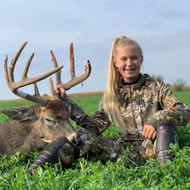One Scent Ahead: Working with the Wind
Posted by Samantha Simma on Sep 28th 2020
Hunting requires that we consider the senses animals use to detect danger. When you think of the five primary senses (sight, sound, touch, smell, and taste), it’s sight, sound, or smell that will most likely reveal you to whatever prey you’re after. Now, you can combat sight by outfitting yourself in camouflage (that’s where DSG gear takes center stage). And minimizing the sounds you make mostly just takes some practice. But what about scent?
On a basic level, every animal will give off its own scent. For humans, this is coupled with the scent of our soaps (body and laundry soap), lotions, hair products, whatever you apply to your body. We may even carry with us scents from our surroundings--from our homes, our cars, etc. Think about the candles and air fresheners you’ve walked through today--might you smell like pumpkin spice? You can fight off your smell with scent-free products, or mask them with scent eliminators. The Ava set (both the NEW 2.0 version, and the original), features Agion Active® XL dual-action scent control for precisely this purpose.

But you can only do so much to not smell like a human. After that, you have the wind to contend with. Wind carries our smell faster than we can do our stalking, and most hunters start off assuming that all you need to know to not be “winded” by a deer is position yourself downwind. Yes, that’s a start, but every hunting situation is dynamic. You’re moving, the deer may be moving, and the air is definitely moving. So even if you start out your stalk on the downwind side, if you or the deer alter your position you could be found out quite quickly.
Take time to observe your terrain, or learn its subtleties prior to your hunt with a topography map. It’s important to note that even subtle terrain changes can have an effect on wind direction. If possible, you’ll always want to be downwind from a prey’s position (feeding or bed areas), as well as the paths they travel (so they don’t run into your scent). Think of water running in a stream--as that water hits objects in its path, it may move over or around the object, or even curl back on itself. Wind moves similarly: when wind blows freely, without confronting obstacles, it’s easiest to monitor and predict. However, when any obstacle enters its path, its trajectory becomes more irregular.
Another component of wind is thermals, or wind shifts caused by temperature variances. Based on the physics of air particles, air rises in the morning when the sun warms it. Then, in the evenings, when the sun goes down, the air follows suit. Your scent will be carried along in those directions. In a perfect world, you’d hunt animals from above in the morning, and below in the evening. You’ll want to think about all these combined factors as you determine where you position yourself or your stand for a hunt, as well as the path you’ll get to and from your hunting area.

Once you understand how wind works, wind detectors will quickly become essential to your hunting. These can come as powder based or electrical detectors. Powder detectors are quick and convenient--they’re small bottles filled with powder that you puff into the air, and allow you to watch which direction the powder floats away on the wind. Electric detectors are devices that employ a variety of sensors to gauge wind direction. There are also a variety of phone apps out there that will detail or predict wind movement (and some weather apps do this as well). The point is, monitor wind regularly throughout your hunt because wind can do strange things under different conditions. The worst is when it’s twirling and swirling with no predictability. The patience you’ve learned as a hunter will surely be put to the test in such situations!
And guess what? While you’re doing all you can to work the wind, the animal you’re after is doing the same. Animals will exercise their own knowledge of wind movement to give themselves the best chance at detecting danger. So do your best to combine your knowledge of wind with the tools of the trade, and head into your hunt with confidence!

